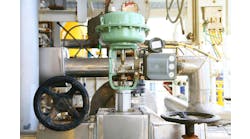The Turck press tour rolled into Putman Media this morning...and those Turck folks really do _work_, pun intended. With a history of high quality and innovation, I expected to see new stuff that was interesting and clever, and I wasn't disappointed, on several levels.
Grant Bistram, director of marketing communications, set up the story, pointing out that Turck has changed...that they produce more instrumentation than people generally know, and that their new mantra is: "Sense it! Connect it! Bus it!"
He reiterated Turck's longtime commitment to being a "products company" rather than a "solutions company," and talked about their 2005 media plans, both print and electronic. Of interest to end users is the fact that their new website (launched last month) finally has all the technical information on all the Turck products, as well as white papers and applications information. Those of us who've used Turck are shouting "Hallelujah!" for this. It is about time, and a darn good resource to boot.
Next, Eric Henefield, with a little bit of title confusion, but whose card calls him business development manager, sensors division, talked about the second-generation UPROX+.
"It is hard to get excited about a new prox switch," he said, "but we think we have something special here." He proceeded to prove it to us.
The fancy Turck UPROX technology got rid of the "range reduction factor" ten years ago, and allowed the relatively fragile (as opposed to, say, an automobile chassis coming down the line) prox sensor to be remoted further from potential damage. Turck showed that this reduced cost of maintenance, and reduced downtime due to accidental damage.
The new UPROX+ includes a unique recessed sensor (most inductive prox can't do this at all) and some other cool features, like the fact that all the sensors are IP68 Protection Class, according to the very stringent Turck definition of the standard. In addition, Turck makes some very neat sensors they call the Washdown series, which meet IP69K (the salt water washdown protection class).
One of the big issues with any prox switch is noise immunity. There are lots of sources of noise in the production floor environment, whether you are making automobiles, or batches of pills, or bottles of beer. Because the UPROX doesn't have a ferrite core, it is absolutely immune to one of the worst kinds of noise that causes false trips all the time: welding fields. Turck claims the new sensors are made to meet EN50082-2 and also the forthcoming EN61000-4-6 that will come into force in 2006. They defeat EMI by using a 1.2 MHz oscillation frequency...so high that most EMI sources don't bother the sensor.
"The bottom line to all of this," Henefield concluded, "is that while Turck sensors are a little bit more expensive on the front end, their Total Cost of Ownership is designed to be much lower than other more conventional prox switches."
Responding to a question from Keith Larson, Henefield noted that Turck often is required to do 100% burn in testing on their sensors due to the fact that they are potted in epoxy, and they need to be certain the sensor works after the manufacturing process is completed.
Bob Gardner, product manager-i/o for the networks and interface division (what used to be Interlink BT before Turck bought Banner out last year) introduced us to his "better to be lucky than good" design, the new BL67 connectorized i/o system. This unit has some big benefits that were designed in, and some really neat uses that Gardner said, "I wish I could take credit for thinking these up, but our customers did that." The BL67 was designed, Gardner noted, to be a connectorized, bus connected marshalling box for PLC i/o, but it appears to be able to do more than just that.
The unit allows installation to a DIN-rail, without an enclosure, without terminal blocks, and in a significantly smaller footprint. This makes rewiring easy, and provides a great retrofit platform for field wiring with fewer wiring errors and according to Turck, lower cost, with easier troubleshooting.
Now for the fun stuff. Gardner explained that several customers had actually started using the device in a way not anticipated: as a field monitoring device connected to a plant asset management system, or other data collection system, outside of the control system.
"The Control System remains unchanged," he noted,"so there is no need to recertify for FDA or USDA purposes."
He noted that people who do compliance reporting and asset management systems are often from a different department than plant operations personnel, and certainly different than the machine builder or OEM who originally manufactured the machine. So it makes sense to be able to provide a standalone monitoring system.
He admitted that there might be room in the future for some limited data analysis in the BL67, somewhat like the recently introduced Emerson CSI condition monitoring system, but the existing BL67 design already allows for use as the field end of an asset monitoring system by the maintenance department.
The BL67 supports DeviceNet, Profibus, Ethernet IP and Modbus TCP/ethernet fieldbus protocols. There are no plans currently to support Foundation Fieldbus, but I suspect that as the neat, synergistic application's use spreads, they'll be getting requests from process automation companies to make it easier to integrate into FF HSE networks.
Because the BL67 supports ethernet directly, it can be interfaced easily with a wireless node system, again making its use in asset management a real plus.
Gardner showed part of a Powerpoint presentation sent to him by one of Turck's customers, Automatic Feed Company, which makes steel coil handling and feeding machines for automotive and other fabrication plants.
"We moved the industrial controls and hardware devices onto our standard, modular DDA stands," the Powerpoint said. This, according to Automatic Feed produced gargantuan (and I use the word without any hyperbole at all) cost savings in both equipment costs, manpower time and manpower costs.
Gardner showed a slide, produced by Automatic Feed, tabulating the various cost savings areas, such as the fact that by using connectorized i/o and sensors, they were able to cut wiring time from 1800 hours to 900 hours by the second new-design machine, with a goal of 450 hours they believe is achievable. If you figure that each hour costs roughly $25, burdened, just this cost saving alone was upward of $25,000 PER MACHINE. And clearly, they aren't going to lower the selling price. Even the cost of the hardware, Automatic Feed claimed, was reduced by about 25%.
Because this was Automatic Feed Company's data, Turck is going to have to get permission to give us the presentation so we can use it, but in the meantime, if you want to ask Automatic Feed Company questions, you can call Kim Beck, the company president. See their website, http://www.automaticfeed.com for contact information.
Finally, Karen Knoblock, the marketing manager, told us about Turck's certification program.
The Turck Certified Contractor Program was designed to help contractors and system integrators learn how to do connectorized and fieldbus installations (certainly pointing them toward using Turck for doing this). It is a really good program, though proprietary, and many contractors are using the certification as part of credentialling for proposals and maybe even CSIA Registered Member audits.
This is just another sign of the serious problem facing the automation community with respect to training and education. "Turck isn't in the training business," Knoblock stated. But clearly, they were responding to a need that their customers communicated to them, that nobody else, not ISA or any other organization, was meeting for this kind of training.
Once again, a novel response from a company with a history of them.
Murray Death, Turck's vice president, closed out the session by talking about why Turck wants to remain a products company. He reminded us of the ARC meeting in Orlando several years ago when Donn Davis and John Berra and Andy Chatha stood up and talked about being a "total solutions provider." Everybody there was climbing on the "solutions" bandwagon. Murray said he was sitting next to a couple of engineers from Anheuser-Busch, and one of the engineers turned to the other and said, "Jeez, ain't anybody making any products anymore?"
Leaders relevant to this article:



